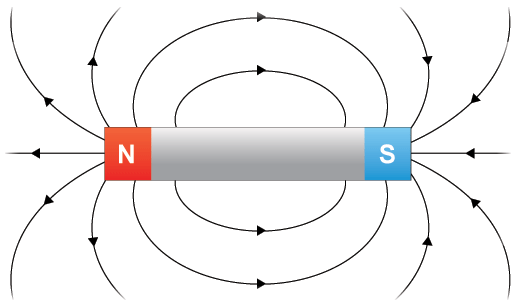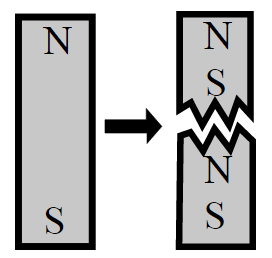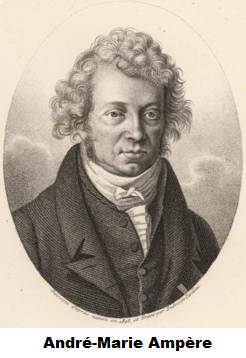
We have already learned something about electrostatics last times. Now we turn to focus on magnetostatics.
In history, for some reasons, although magnets and magnetism were known earlier, the study of magnetism was not going smoothly. Sometimes it was almost just analogy.
First we also have a Coulomb’s law:$$|\vec{F}|=\frac{q_1 q_2}{4\pi\mu_0 r^2}$$
Exactly the same equation we have in electrostatics, the differences are: vacuum permittivity is replaced by vacuum permeability, and the charges are no longer electric charges but “magnetic charges” or “magnetic poles”, aka magnetic monopoles. Later in 1824, Siméon Denis Poisson created the first successful model of the magnetic field. In this model, a magnetic $\vec{H}$-field is produced by ‘magnetic poles’ and magnetism is due to small pairs of north/south magnetic poles. $\vec{H}$ is magnetic field strength. We also have the following equation: $$\vec{B}=\mu_0(\vec{H}+\vec{M})$$
$\vec{B}$ is called magnetic field strength, $\vec{M}$ is called magnetization intensity. Just like polarization, here we have magnetization. Also, if the medium is linear and isotropic:
$$\begin{aligned}
\vec{B}=\mu_0(\vec{H}+\chi_m\vec{H})=\mu_0 \mu_r \vec{H}=\mu \vec{H}
\end{aligned}$$
If we take a look back:
$$\begin{aligned}
\vec{D}=(1+\chi)\varepsilon_0\vec{E}=\varepsilon_r\varepsilon_0 \vec{E}=\varepsilon \vec{E}
\end{aligned}$$
They are TOTALLY the same.
HOWEVER, those theories are all based on “magnetic poles”. Are they really exist? In 1785, Charles-Augustin de Coulomb himself experimentally verified this and stated explicitly that the north and south poles cannot be separated. So what really produces magnetic force?

Three discoveries challenged this foundation of magnetism. First, in 1819, Hans Christian Ørsted discovered that an electric current generates a magnetic field encircling it. Then in 1820, André-Marie Ampère showed that parallel wires having currents in the same direction attract one another. Finally, Jean-Baptiste Biot and Félix Savart discovered the Biot–Savart law in 1820, which correctly predicts the magnetic field around any current-carrying wire.
Extending these experiments, Ampère published his own successful model of magnetism in 1825. In it, he showed the equivalence of electrical currents to magnets and proposed that magnetism is due to perpetually flowing loops of current instead of the dipoles of magnetic charge in Poisson’s model. This has the additional benefit of explaining why magnetic charge can not be isolated. Further, Ampère derived both Ampère’s force law describing the force between two currents and Ampère’s law, which, like the Biot–Savart law, correctly described the magnetic field generated by a steady current. Also in this work, Ampère introduced the term electrodynamics to describe the relationship between electricity and magnetism.

From our modern perspectives, unified theory is still fashionable. Ampère made a big step toward it.
a). Biot–Savart Law
In a vacuum:
$$\begin{aligned}
\vec{B}=\int d\vec{B}=\frac{\mu_0}{4\pi}\int_{l'}\frac{I'dl'\times(\vec{r}-\vec{r'})}{|\vec{r}-\vec{r'}|^3}
\end{aligned}$$
b). Ampère’s Circuital Law
In a vacuum:
$$\begin{aligned}
\oint\vec{B} \cdot d\vec{l}=\mu_0\sum I
\end{aligned}$$
The direction of the current is related to the direction of the $\vec{B}$ circle, by using the right hand rule.
In other mediums, we have to take magnetization into account:
$$\begin{aligned}
\oint\vec{H}\cdot d\vec{l}=I
\end{aligned}$$
The relationship of $\vec{B}$, $\vec{H}$, and $\vec{M}$ is correct, but we’d like to write it in a different form:
$$\begin{aligned}
\vec{H}=\frac{\vec{B}}{\mu_0}-\vec{M}
\end{aligned}$$
c). Fundamental Equations
Integral form:
$$\left\{
\begin{aligned}
&\oint_S \vec{B} \cdot d\vec{S}=0\\
&\oint \vec{H} \cdot d\vec{l}=I\\
\end{aligned}
\right.$$
Differential form:
$$\left\{
\begin{aligned}
&\nabla \cdot \vec{B}=0\\
&\nabla \times \vec{H}=\vec{J}\\
\end{aligned}
\right.$$
Now we know that static magnetic fields are rotational, and divergence-free.
d). Magnetic Potential
Now we are going to define magnetic potential to measure the rotation of a static magnetic field, just like what we did in electric potential.
$$\vec{B}=\nabla\times\vec{A}$$
$$\Psi=\int_S \vec{B} \cdot d\vec{S}=\int_S (\nabla \times \vec{A})\cdot d\ vec{S}=\oint_L \vec{A}\cdot d\vec{l}$$
This is not enough, we also want to define magnetic scholar potential by analogy.
$$\vec{H}=-\nabla \varphi_m$$
e). Boundary Conditions
Near to the boundary line of two static electric fields:
$$\left\{
\begin{aligned}
&\vec{B}_{2n}=\vec{B}_{1n}\\
&\vec{H}_{1t}-\vec{H}_{2t}=\vec{K}\\
\end{aligned}
\right.$$
$\vec{K}$ is the linear current density.
Represented with magnetic potential, if the field is axisymmetric:
$$\left\{
\begin{aligned}
&\vec{A_1}=\vec{A_2}\\
&\frac{1}{\mu_1}\frac{\partial \vec{A_1}}{\partial n}-\frac{1}{\mu_2}\frac{\partial \vec{A_2}}{\partial n}=\vec{K}\\
\end{aligned}
\right.$$
Represented with magnetic scholar potential:
$$\left\{
\begin{aligned}
&\varphi_{m1}=\varphi_{m2}\\
&\mu_1 \frac{\partial \varphi_{m1}}{\partial n}=\mu_2 \frac{\partial \varphi_{m2}}{\partial n}\\
\end{aligned}
\right.$$
f). Basic Questions
Almost the same in electrostatics.
How can we know the effect of a field if we already knew something about the source? How can we know something about a source if we already knew the effect of the field it excited?
Answers:
- Biot–Savart law ( for continuous objects ).
- Ampère’s circuital law ( for electric wires ).
- Boundary conditions, along with Poisson’s equation: $\nabla^2\cdot\vec{A}=-\mu\vec{J}$, or Laplace’s equation: $\nabla^2\varphi_m=0$ in vector form ( in a force-free magnetic field ).
- Method of images ( for different mediums ).
g). Energy
Self inductance: $\Psi=LI$
Mutual inductance: $\Psi=MI$
For coils:
$$\begin{aligned}
W_m=\frac{1}{2}\sum_{i=1}^{n} I_i \Psi_i
\end{aligned}$$
For magnetic bodies: $$W_m=\frac{1}{2}\int_V \vec{H}\cdot\vec{B}dV$$
That’s all.
HOWEVER… what if magnetic monopole does exist and someone finds it out?
References:
- Liu,Wenkai. Electromagnetic Fields and Electromagnetic Waves. [M]. Beijing: BUPT Press, 2013.
- Wikipedia [EB/OL]. https://en.wikipedia.org, 2016-03-06.